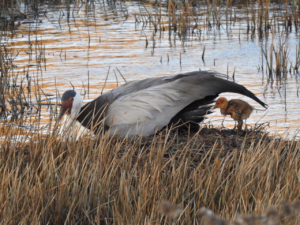 Frequently asked questions about the Wattled Cranes.
Frequently asked questions about the Wattled Cranes.
- What is a floater flock? A floater flock are the juveniles and adult birds that are too young to pair up and breed so they flock together during breeding season while the mature birds go off to breed.
- When do Wattled cranes breed? Wattled cranes are winter breeders, so generally breed from about April to approximately November.
- Where do they breed? Wattled cranes breed in wetlands, so will make a nest in a dam that is part of a healthy wetland system.
- At what age do they start breeding?
- What do Wattled crane nests look like? Wattled cranes make nests in dams. The nests are surrounded by water as this provides protection against predators that don’t like water like serval and jackal. Their nests are mounds made from reeds and mud.
- How many eggs do wattled cranes lay? They will normally lay 2 eggs, three days apart. They incubate them for 33-36 days. Once the first egg has hatched, they will continue to incubate the second egg until they know that the first chick is healthy and will then abandon the second egg. They only raise one chick.
- Why do they only raise one chick? They are known to only raise one chick and use the second egg as a back-up. When the chicks are born, they are fully developed and can walk and swim straight away. The parents are extremely protective and very good parents.
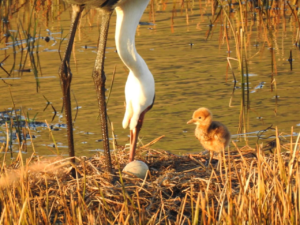
- At what age does the chick start flying/fledge? The chicks fledge at about 5 months but will stay with the parents for a year until the next breeding season, where the juvenile will join the floater flock.
- How can you distinguish a young Wattled crane once it has reached adult size? The grey patch on the top of its head will still be white or speckled with grey and will eventually go completely grey.
- Do Wattled cranes roost in trees? No, they roost in water. Unlike the Grey Crowned crane, the Wattled and Blue cranes cannot grip a branch as they don’t have a “thumb” to hold onto a branch with and both roost in water whereas the Crowned cranes roost in trees.
- How many Wattled cranes are left in South Africa? The aerial survey last year determined that there are 399 Wattled cranes in South Africa.
- Are Wattled cranes endangered? Yes, they are listed as VULNERABLE.
- What do Wattled cranes eat? They are omnivores and eat mainly rhizomes and tubers of reeds and water lilies, but will also eat snails, amphibians, earthworms and snakes should the occasion arise.
- Do they pair for life? Yes, Wattled cranes are monogamous and pair for life.How tall are wattled cranes? They are between 1.5 – 1.8 m tall, with a wingspan of between 2.3 – 2.6m and weigh between 6 – 9kg.
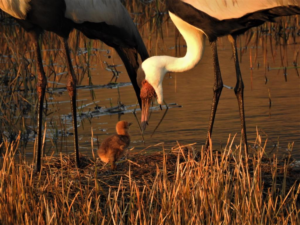
- What threats are there for the cranes? Humans, Jackal, serval, dogs and power lines just to name a few.
- Do the migrate? No, they don’t.
- How did they get their name? Their name comes from the wattles that hang under their chins.
- Where are Wattled cranes found? They are found in 11 countries in Africa with the biggest population being in Zambia with a estimated population of 3000.
- FUN FACT – Wattled Cranes have flaps of skin or “wattles” hanging from their chin that can indicate their mood – the wattles shrink if the crane is nervous or elongate if they are excited.
Frequently asked questions about Grey Crowned cranes.
- When do Grey Crowned cranes breed? Grey Crowned cranes are summer breeders, so will normally breed from September to March.
- Where do they breed? They breed in the wetlands, but unlike the Wattled cranes their nests are in the reeds and grass.
- What does the nest look like? They make the nests from grass and reeds which forms a platform and basically floats in the water.
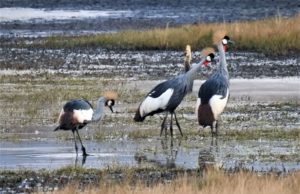
- How many eggs do they lay? They lay anything from 2 – 5 eggs white eggs which both female and male will incubate. They incubate them for 28 – 31 days and will normally hatch 24 hours apart. They will normally rear 2 chicks. When the chicks are born, they are already fully developed and are able to walk, run and swim.
- At what age do the chicks fledge/fly? Anything from 55 – 100 days from birth.
- What do they eat? They are omnivores, eating grass tips, nuts, soybeans, maize, and millet as well as insects and other small animals including frogs, snakes, fish and aquatic eggs.
- Where do Grey Crowned cranes roost? They are the only crane species that roost in trees as they have a fourth “toe” that enables them hold onto a branch, they also roost in dams.
- Are they endangered? Yes, they are listed as ENDANGERED by the IUCN as their numbers are declining.
- How many are left in South Africa? It is estimated that there are approximately 6500 left.
- Do they pair for life? Yes, they are monogamous and pair for life.
- What threats are there for the cranes? As a result of their beauty, they are caught and sold to zoos and private households, so humans are probably their main threat. Poisoning, power lines and predators just to name a few other threats.
- How tall do they get? Grey Crowned cranes are the smallest of the three cranes found in South Africa standing at a metre high with a wingspan of up to 2m and weigh approximately 3.5kg.
- Do they migrate? No, they don’t.
- How do they make that guttural sound you hear when they are at the hide? If you watch their red wattle, you will see they inflate it with air and as they push the air out, it makes a guttural sound. They pull their necks into their shoulders when they make the sound. There are normally two or three cranes that sit together and chorus.
- What is the difference between the Black Crowned crane and the Grey Crowned crane? It is very similar but distinguished by a darker colouration on its neck and body and with more pink on its face. It is Ugandas national bird.
- FUN FACT – They get their name from the beautiful crown of golden feathers on their head. Their call is very distinguishable – ‘MAAAHEM’ which is also actually the Afrikaans name for them.
Frequently asked questions about the Blue Crane.
- Where do Blue Cranes nest? They nest in open grasslands, agricultural areas and even wetlands.
- What do their nests look like? Their nests are nothing like the Wattled and Grey Crowned crane nests, it is literally a scrape in the ground with few sticks and stones pushed together.
- How did they get their name? Their name comes from the fact that when the light shines on them, their feathers have blueish hue to them. They are also known as the Stanley Crane or Paradise crane.
- The Blue Crane is our national bird.
- Are Blue Cranes endangered? Yes, they are listed as Vulnerable by the IUCN.
- When do Blue cranes breed? They are summer breeders, normally from about September to March.
- How many chicks do they rear? Blue cranes usually lay up to 2 eggs and have been known to rear both chicks. Males and females both incubate the eggs, most of the time the males will sit on them at night and females during the day.
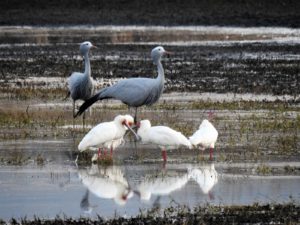
- How long do they incubate them for? For between 30 – 33 days.
- When do the chicks fledge/fly? The chicks will fledge from 3 – 5 months old and will stay with the parents until the next breeding season.
- Where do Blue Cranes roost? They roost in dams, they DO NOT roost in trees.
- Do they migrate? They are altitudinal migrants, meaning they generally nest in the lower grasslands at altitudes of between 1300 – 2000m and will move to lower altitudes for winter, all within South Africa.
- Blue cranes are near-endemic to South Africa, with a small population of about 60 – 80 birds in the Etosha Pans in Namibia and a few isolated birds in Botswana and Swaziland.
- Blue cranes mostly prefer dry, open grasslands. In the breeding season they prefer areas that have access to both grassland and wetlands.
- How big are they? Blue cranes are approximately 1 – 1.2m tall with a wingspan of between 1.8 – 2m and they weigh between 3.6 – 6.2kg.
- What do they eat? They eat grasses and sedges, but also eat insects like grasshoppers, crabs, snails, frogs and snakes which get broken up and fed to the chicks.
- What threats are there to the Blue Cranes? Loss of habitat by human development, forestry, poaching, poisoning – deliberate to protect crops or accidental by baits intended for other species, collisions with power lines, to name a few.
- What is the Blue Crane population? Approximately 25 000.
- Do Blue cranes mate for life? Yes, they are monogamous and display a beautiful courtship dance where they both jump up and down with their wings extended.
- How old are they when they can start breeding? The Blue cranes reach maturity at about 3 – 5 years of age.
FUN FACT – Blue cranes have been known to moult – partially or sometime completely and they then become flightless! It can take up to two months for their flight feathers to grow back. There are certain areas in the Western Cape that they use a moulting ‘ground’, they return there every year to moult
